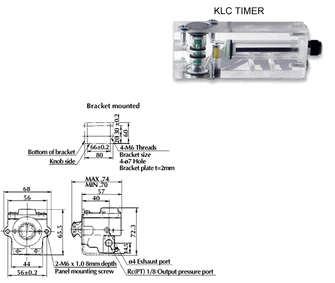Authorized National Elite Distributor
for the SMC Corporation of America
Authorized National Elite Distributor
for the SMC Corporation of America
 |
||||||||||||||||||||||||||||
 |
||||||||||||||||||||||||||||
|
Air Timers/Timed Delay Relays
|
||||||||||||||||||||||||||||
|
Air timers and timed delay relays are an essential component of many industrial and commercial pneumatic systems. At Orange Coast Pneumatics, we offer several, diverse models from SMC Corporation of America. Find the best pneumatic timer relay for your operations; then, continue reading to learn more about these devices and their benefits for you. What are Pneumatic Timers?Pneumatic timers are devices used in industrial and commercial pneumatic systems to control the flow of compressed air. They are used when you must delay the air signal entering or exiting your air components. Depending on the model chosen, the air time delay may be adjusted from 0.5 to 60 seconds. These timers are used for a variety of applications, such as controlling:
PneuairePneuaire offers two, different timed delay relay air timers. The NVR Air Timer offers a combination of adjustable orifice and fixed flow, enabling transmission of a pneumatic signal after a fixed time period. Our NVR air timers are available in normally closed (NC) only. KLC Air Timers are available in either normally closed (NC) or normally open (NO) models. Normally closed models are used to time in and normally open models are used to time out. Once set, our air timers are accurate for repeatability to ±10% with regulated air pressure. Filtration recommended is 40 micron, while pressure range is 50-150 psi. What is the Difference between Air Timers and Relay Timers?Air timers and relay timers are two types of pneumatic timers that differ in how they create a delay. Air timers use a small amount of compressed air, while relay timers use an electrical signal to create a delay. Air timers are often used in applications where compressed air is readily available. Alternatively, relay timers are used in applications where electrical control signals are more sensible for triggering the timer. How Does a Pneumatic Timer Delay Valve Work?A pneumatic timer delay valve works by using a small amount of compressed air to create a delay before a valve is actuated. The delay is achieved by restricting the flow of air through the valve with an adjustable orifice. When the valve is initially actuated, a small amount of air is allowed to flow through the orifice, but the flow is restricted, causing the air pressure to build up behind the valve. As the pressure builds, it reaches a point where it overcomes the restriction, and the valve actuates. The amount of delay can be adjusted by changing the size of the orifice or by changing the pressure at which the valve is actuated. Pneumatic timers are reliable, easy to use, and can be used in a wide range of applications. |
||||||||||||||||||||||||||||
|
||||||||||||||||||||||||||||
| NVR Air Timer NVR2 110-N01 | NVR2110-N01 | |||||||||||||||||||||||||||
| KLC Air Timer KLC- 105 | KLC-105 | |||||||||||||||||||||||||||
| KLH Air Timer KLH- 105 | KLH-105 | |||||||||||||||||||||||||||